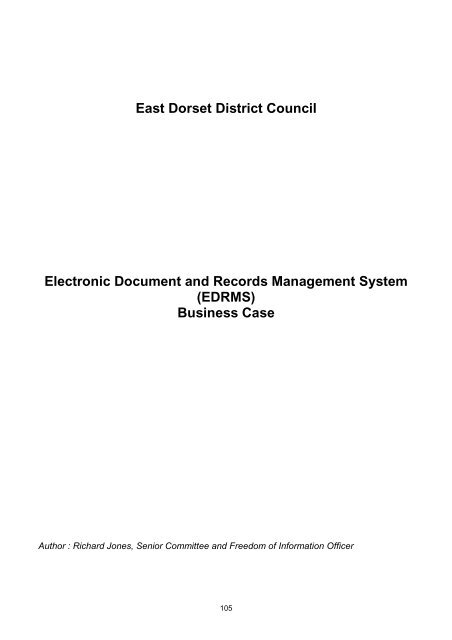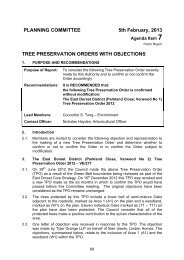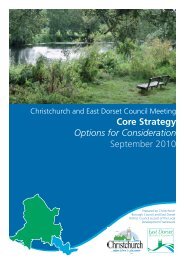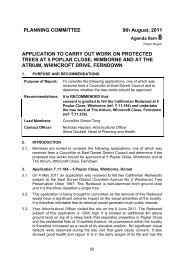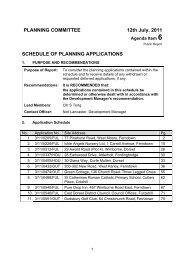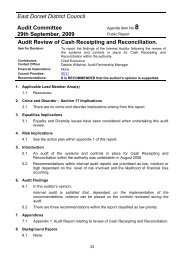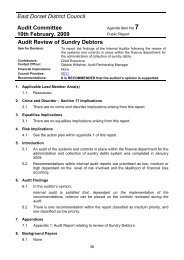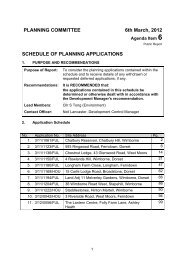Electronic Document and Records Management System
Electronic Document and Records Management System
Electronic Document and Records Management System
You also want an ePaper? Increase the reach of your titles
YUMPU automatically turns print PDFs into web optimized ePapers that Google loves.
Introduction1. Purpose Of <strong>Document</strong>1.1 This document sets out a detailed business case for the procurement <strong>and</strong>implementation of a modulated <strong>Electronic</strong> <strong>Records</strong> <strong>Management</strong> <strong>System</strong> tooperate in collaboration with Microsoft SharePoint Portal 2003. It covers thepreferred business <strong>and</strong> technical options <strong>and</strong> seeks project approval for theoutline costs <strong>and</strong> scope identified.2. Abbreviations <strong>and</strong> Definitions2.1 Throughout this document the following abbreviations will be used:-• ERMS = <strong>Electronic</strong> <strong>Records</strong> <strong>Management</strong> <strong>System</strong>• EDMS = <strong>Electronic</strong> <strong>Document</strong> <strong>Management</strong> <strong>System</strong>• EDRMS = <strong>Electronic</strong> <strong>Document</strong> <strong>and</strong> <strong>Records</strong> <strong>Management</strong> <strong>System</strong> (acollaboration of ERMS <strong>and</strong> EDMS solutions).2.2 For the purposes of this project definitions for ERMS <strong>and</strong> EDMS are taken from‘Model Requirements for the <strong>Management</strong> of <strong>Electronic</strong> <strong>Records</strong>’ (MoReq),published by the Interchange of Data between Administrations Programme of theEuropean Commission, which provides a useful guide to the differences betweenelectronic document management systems <strong>and</strong> electronic records managementsystems:-An EDMS….Allows documents to be modified<strong>and</strong>/or to exist in several versionsMay allow documents to bedeleted by their ownersMay include some retentioncontrolsMay include a document storagestructure, which may be under thecontrol of usersIs intended primarily to supportday-to-day use of documents forongoing businessAn ERMS….Prevents records from being modifiedPrevents records from being deleted exceptin certain strictly controlled circumstancesMust include rigorous retention controlsMust include rigorous record arrangementstructure (the classification) which ismaintained by the administratorMay support day-to-day working, but isintended to provide a secure repository formeaningful business records3. Approval3.1 The business case will be examined by the ICT Working Party <strong>and</strong> recommendedfor approval by the Policy <strong>and</strong> Resources Committee.Background <strong>and</strong> Need for Change4. Background4.1 The Council has a large amount of knowledge tied up in many structured, semistructured<strong>and</strong> unstructured information sources, for example hard copies storedin filing cabinets, hard copies in storage, archived records on microfilm/microfiche,electronic files in back office application systems (e.g. benefits, council tax) <strong>and</strong>related files held in unstructured systems such as e-mails, word documents, etc.106
4.2 The Council does not have an existing policy for records management, <strong>and</strong> thereare very few procedures in place within the Council at the present time toeffectively manage the creation, maintenance, storage, use <strong>and</strong> disposal ofrecords.4.3 The perceived importance of maintaining the traditional semi-structured paperbasedfiling systems has declined as users favour the use of technology <strong>and</strong> theease of saving information electronically. In the absence of any control, however,information is being stored electronically in unstructured systems, with no controlof versions, duplication, access or disposal. The explosion of electronicinformation storage has resulted in an equal proliferation of server facilities <strong>and</strong>the consequential dem<strong>and</strong>s in maintenance.4.4 Studies have shown that employees within medium sized organisations spend anaverage of 25 minutes a day looking for information. For each 20 office-basedemployees, this equates to the equivalent of 1 full-time employee per annum.5. Drivers For Change5.1 The Council’s Mission Statements for the Resources <strong>and</strong> Performance StrategicTheme areas respectively are:-• To ensure a sound basis for service provision is delivered by effectivemanagement of the Council’s human, financial, technological <strong>and</strong> physicalresources; <strong>and</strong>• To secure continuous improvement through development in the quality ofworking practices, drawing on best experience inside <strong>and</strong> outside theCouncil, within a culture which embraces critical review <strong>and</strong> change.5.2 The Strategic Theme for Resources is supported by 6 core objectives, 3 of which(RE3, RE5 <strong>and</strong> RE6) are supported by the introduction of an EDRMS <strong>and</strong>associated policies <strong>and</strong> procedures.• RE3 – Provide Members with the resources to assist them in decisionmaking <strong>and</strong> leadership in the community.• RE5 – Use technology to improve efficiency <strong>and</strong> service delivery.• RE6 – Ensure Council assets are maintained to maximise their useful lifeso that they are safe <strong>and</strong> accessible for users.5.3 The Strategic Theme for Performance is also supported by 6 core objectives, 2 ofwhich (PE2 <strong>and</strong> PE4) are supported by the introduction of an EDRMS <strong>and</strong>associated policies <strong>and</strong> procedures.• PE2 - Meet the challenges of the modernisation agenda by developing theorganisational capacity.• PE4 - Achieve enhanced service through electronic service delivery.5.4 Successful management of information, with the ability for all informationmanagement system processes to deliver accurate, up-to-date information, veryquickly to whoever needs it, via various access channels, is a pre-requisite in thedelivery of the above objectives.5.5 Office accommodation at Furzehill is also at a premium. A full review of records<strong>and</strong> appropriate digitisation will help relieve this pressure <strong>and</strong> reduce the riskcurrently posed by the lack of backup facilities for manual records. Officeaccommodation costs have been calculated at £125 per square metre.5.6 Members will be aware from previous reports on E-Government Priority Servicesthat the ODPM Priority Outcome G19 requires the Council to Implement107
ISO15489 for records management by 31 st March, 2006. It would seem highlydesirable to align the implementation of the <strong>Document</strong> <strong>Management</strong> <strong>and</strong> <strong>Records</strong><strong>Management</strong> projects since there is clearly a high degree of commonality.5.7 Furthermore, the Lord Chancellor has published under Section 46 of the Freedomof Information Act a Code of Practice for the <strong>Management</strong> of <strong>Records</strong>. Adherenceto this Code of Practice is considered to be highly desirable to ensure compliancewith the Freedom of Information Act <strong>and</strong> other Acts of Parliament relating toinformation <strong>and</strong> record-keeping.5.8 There are also other legislative drivers in the form of the requirements of theFreedom of Information Act in general, the Data Protection Act <strong>and</strong> the DisabilityDiscrimination Act, which exert additional influence upon the way that localauthorities manage, maintain <strong>and</strong> present the data in the delivery of services.5.9 The council is required to address its responsibilities for records management <strong>and</strong>separate reports will be presented to the Council in due course addressing allpolicy <strong>and</strong> procedural matters.6. Business Objectives6.1 The core business objectives of establishing an EDRMS solution are:-• To support the business needs of the authority for good record keeping inthe electronic age.• To enable the authority’s corporate memory to be effectively captured <strong>and</strong>safeguarded electronically.• To enable each service unit to manage their documents, in an organisedfashion <strong>and</strong> to share information with all areas of the business whereappropriate.• To store <strong>and</strong> manage all documents centrally <strong>and</strong> allow access remotely.• To facilitate the development of a seamless link from Corporate <strong>System</strong>s toelectronic documents.• To develop capacity to enable continuous improvement.• To improve access to Council information by delivering accurate, up-to-dateinformation, very quickly to whoever needs it.• To assist in ensuring compliance with the legal requirements of theFreedom of Information <strong>and</strong> Data Protection Acts.6.2 EDRMS is a key component that supports many elements of the ModernisingGovernment agenda. It will further support the Council in maintaining its currentCPA status <strong>and</strong> promote further progression through the:-• Modernisation of administrative processes by replacing paper-basedactivities with electronic ones;• Enhancement of management information enabling decisions to be robust,transparent <strong>and</strong> auditable;• Retention <strong>and</strong> maintenance of records delivered electronically to theCouncil <strong>and</strong> enable delivery to the citizen in a way which can servecontinuing operational needs <strong>and</strong> provide reliable evidence if required;• Promotion of joined-up working arrangements between departments <strong>and</strong>service units by enabling information <strong>and</strong> records that represent crossdepartmentalfunctions to be shared;108
• Development of existing applications to integrate with the solution, so thatall information relating to a particular record is delivered seamlessly at thetouch of a button;• Promotion of open <strong>and</strong> accountable local government by increasing theinformation accessible to the public <strong>and</strong> staff, subject to strict accesspermissions.7. Benefits7.1 This project will provide a large number of intangible benefits included in the listbelow. As the project progresses the potential value of many of these benefits willbecome apparent.7.2 The benefits will include:-• Saving of office space• Saving of staff time in searching for documents• Delivery of appropriate incoming post in a timely fashion• Ability to share information immediately• Ability to monitor flows of information• Ability to link all elements of a record• Prevents loss of documents• Large quantities of Information can be stored, with no impact to staff• <strong>Management</strong> of correspondence• Production of management statistics• Adherence to legislative requirements of:-• the Freedom of Information Act• the Data Protection Act• the Lord Chancellor’s Code of Practice• Support of E-government targets• Implementation of ISO 15489• Capacity planning• <strong>Document</strong> archiving• Picture build up of a situation or case8. Method of Approach8.1 The National Archives, formerly the Public <strong>Records</strong> Office (PRO), provides advice<strong>and</strong> guidance to records managers for central government <strong>and</strong> has developedfunctional specifications for ERMS solutions.8.2 The specification covers the entire life cycle of public records, in whatever format,from creation through to destruction or transfer to archive. The CoreRequirements set by the specification includes:-(a) Record Organisation(b) Record Capture, Declaration <strong>and</strong> <strong>Management</strong>(c) Search, Display <strong>and</strong> Presentation109
(d) Retention <strong>and</strong> Disposal(e) Access Control(f) Audit(g) Reporting(h) Usability(i) Design <strong>and</strong> Performance(j) St<strong>and</strong>ards Compliance8.3 In addition, the specification includes optional requirements regardingAuthentication <strong>and</strong> Encryption, <strong>Document</strong> <strong>Management</strong> <strong>and</strong> the <strong>Management</strong> ofHybrid <strong>and</strong> Physical Folders.8.4 No such specification exists for local government <strong>and</strong> defining a specification foruse of ERMS within a Local Authority would be an unachievable task within theresource <strong>and</strong> time available within this project. The Lord Chancellor in his Code ofPractice further encourages Local Authorities to use this specification indeveloping their ERMS projects.8.5 The latest National Archives specification (TNA 2002) for ERMS will therefore betaken as the starting point for defining the requirements for any chosen system,although it is acknowledged that this has some associated risks. The NationalArchives also has an approval scheme for ERMS products assessed against theirfunctional requirements. It would similarly seem sensible to proceed with anapproved product.8.6 The Dorset Freedom of Information Working Group further commissionedconsultants to undertake a feasibility study of records management within all theAuthorities in Dorset. The study was funded by a grant from the ODPM. One ofthe outcomes of this project was to recommend software suppliers for ERMS. Thestudy identified a number of suppliers, however, this was a generic list <strong>and</strong> did notmake individual recommendations for each authority. It is worth highlighting,however, that the list of recommended suppliers was based on the NationalArchives approved list.8.7 At this stage, only one of the products approved against the TNA 2002specifications has been specifically tested whilst operating in collaboration withMicrosoft SharePoint Portal 2003. The National Archives website providesadditional information as to the assessment that was undertaken in evaluating theproduct:“Both the MS SharePoint <strong>and</strong> the Meridio 4.2 EDRM Accelerator interfaceswere examined throughout the test process of this integrated solution. All therequired functionality is available within the Meridio 4.2 EDRM Acceleratorinterface <strong>and</strong> some functionality is also available within the MS SharePointPortal Server 2003 interface primarily, but not exclusively, for end users. TheNational Archives approval of this product is based on users having access toboth interfaces as required.”8.8 On this basis, it is recommended that, should this business case for a full EDRMSsolution for the Council be supported, Meridio V4.2 EDRMS Accelerator beselected as the preferred solution at this stage. There is an optional workflowsolution to manage requests for information submitted under the Freedom ofInformation Act, however, the appropriateness of this solution will be assessed indetail when the project is underway.110
9. Cost9.1 A total of £65,000 was allocated for the implementation of document managementin June 2002. £34,000 has yet to be spent, £16,000 of which is ear-marked forscanning facilities.9.2 There will be costs associated with linking the EDRMS to back end systems, butthis cannot be established until post-implementation of the records managementsolution <strong>and</strong> following dialog with our back-end system suppliers. Priorities willneed to be identified against business requirement criteria.9.3 There are also costs associated with various options around scanning <strong>and</strong> thesolution chosen. A volumetric study is being undertaken to determine therequirements <strong>and</strong> options for internal/bureau scanning facilities, <strong>and</strong>centralised/devolved scanning facilities.9.4 A scanning bureau could be used, for example, to scan documents larger that A3if insufficient quantities justified internal equipment <strong>and</strong> for appropriate backscanning.9.5 Purchasing scanners for each service area will be high, but will be more evenlyspread as the rollout would be done in a structured approach <strong>and</strong> so each time aservice area is introduced so a new scanner would be purchased. Since therollout period is expected to be relatively short so the benefits of this spread wouldbe diluted. There would be ongoing costs for the maintenance for each scanner,<strong>and</strong> then a replacement programme, as with the PC replacement programmecurrently being undertaken.9.6 Alternatively, a central scanning function, would have the highest initial set-upcosts, but would be the most efficient in the longer term as there would be little ifany costs associated with an increase in the service. As scanning would becentral, so larger scanners would be purchased, but there would be fewer of them.There would also be an initial cost to train appropriate staff.9.7 Regardless of the scanning solution chosen, a re-engineering of businessprocesses is required which will take some time. There would also be a largeamount of time involved in re-training staff, <strong>and</strong> dealing with the cultural changes.Investment Appraisal10. Do Nothing - MS SharePoint Portal 200310.1 The authority could continue to deliver information through its current channels,<strong>and</strong> not proceed with this project. This would, however, run a very real risk offailing to meet the FOI targets of delivering information requested by the citizen ina timely fashion <strong>and</strong> would not ensure compliance the Lord Chancellor’s Code ofPractice for the <strong>Management</strong> of <strong>Records</strong>, <strong>and</strong> thus render the Council liable,through non-provision of requested information.10.2 SharePoint is an extremely powerful tool. Its primary strength is that of a portal,designed to provide collaboration <strong>and</strong> productivity aids by enabling resources <strong>and</strong>information to be shared effectively <strong>and</strong> efficiently between multiple users, eitherin series or concurrently.10.3 However, SharePoint will not deliver all the functional requirements set by theNational Archives as set out in paragraph 8.2 above nor will it be compliant withISO 15489. As an example, a sophisticated EDRMS assigns security settings toeach <strong>Document</strong> <strong>and</strong> each Record it holds individually. This security enablesdifferent users to access the same folder <strong>and</strong> yet still have differing rights tomanage <strong>and</strong> manipulate the items held within this folder. Without this security any111
user able to delete from within the folder, would be able to delete any item(accidentally or deliberately). In addition to this highly secure environment, anEDRMS automatically creates a complete audit history for the information itmanages, providing evidence about who accessed what information, when <strong>and</strong>what changes were made, etc. Without an EDRMS, neither <strong>Document</strong> levelsecurity, nor an automatic audit trail would be available.10.4 There are no costs to acquiring MS SharePoint Portal 2003 since the Councilalready acquired this software through the Microsoft Enterprise Agreement. Thecosts of implementing any scanning elements would be fairly similar to the fullEDRMS solution, <strong>and</strong> so the outlay would be considerable in relation to therecords management benefits expected.10.5 ISSUES:• No management data• High risk of liability for non production of information• Continued pressure for office space due to a lack of <strong>Records</strong> <strong>Management</strong>control• Continued risk of lost documents• Dedicated resources required throughout authority to manage post• Correspondence not always responded to• Continued staff time wasted in searching for documents <strong>and</strong> files• Location of Scanners• Remote (i.e. Bureau based)• Centralised• Local (i.e. within each service area)• Back-scanning – How much should be undertaken?• Data held on Micro fiche11. EDRMS11.1 The provision of a full EDRMS solution will deliver all the benefits <strong>and</strong> facilitatecompliance with the Freedom of Information Act <strong>and</strong> the associated Codes ofPractice ensuring the provision of information in a timely fashion. Corporatemanagement information will be available <strong>and</strong> information will be controlled toensure information is retained only for as long as the business purpose requires it.Both physical <strong>and</strong> electronic storage space should be released <strong>and</strong> re-used inaccordance with approved destruction <strong>and</strong> retention policies.11.2 ISSUES:• Location of Scanners• Remote (i.e. Bureau based)• Centralised• Local (i.e. within each service area)• Back-scanning – How much should be undertaken?• Data held on micro fiche• Business process re-engineering112
• Cultural shift• The linking of EDRMS into the back office systems• The future development of internal applications to allow ERMS functionality11.3 The table below provides an outline of the likely costs associated with this project.The implementation of a records management solution is a substantialundertaking that will impact upon all service units of the Council. Detaileddiscussions will need to take place with the selected supplier to determine theexact requirements. However, the costs provided are expected to be in line withthe final costs.Estimated Outline Costs £Initials Costs:Meridio Software (250 users) 37,500.00Kofax Ascent Capture Scan station, 25K images per8,200.00month (4)Kofax Full Text PDF, 125K images per month 2,500.008 x Scanners of various speeds (up to A3) for 11,600.00centralised <strong>and</strong> devolved deploymentImplementation services of third party supplier 23,800.00Operating Server for Meridio 6,000.00Re-configuration of Storage Area Network (SAN) 2,000.00Less Allocated FundsAllocation for Scanning (16,000.00)<strong>Document</strong> <strong>Management</strong> (18,000.00)Total Initial Costs 57,600.00Recurring Revenue Costs:Hardware Maintenance 925.00Kofax Licensing 1,875.00Third party supplier telephone support 2,000.00Meridio Maintenance (250 users) 3,375.00Total Recurring Costs 8,175.0011.4 There may be additional costs in future to exp<strong>and</strong> the capacity of the existingStorage Area Network (SAN) but this cannot be determined until a volumetricstudy of requirements has been completed.12. Savings12.1 As detailed in Section 7 of this report, there are likely to be some significantsavings from the introduction of a corporate EDRMS solution, however, thesehave not been quantified in the table above as they are likely to be of a capacity orintangible nature <strong>and</strong> therefore the monetary value will not be realised.12.2 It should be noted that savings were identified in the business case for documentmanagement but these have yet to be realised <strong>and</strong> therefore moving the projectforward expediently will realise these savings.113


